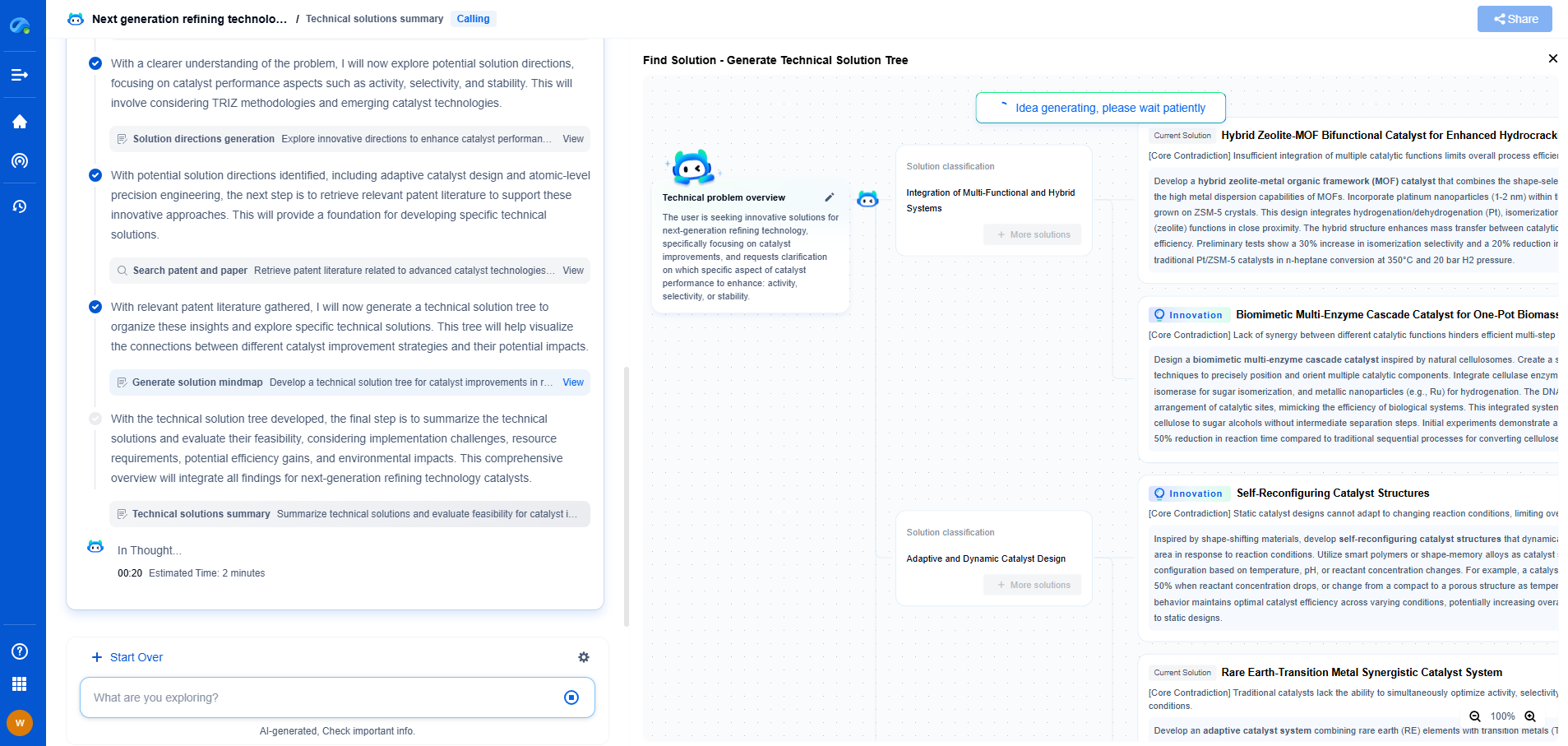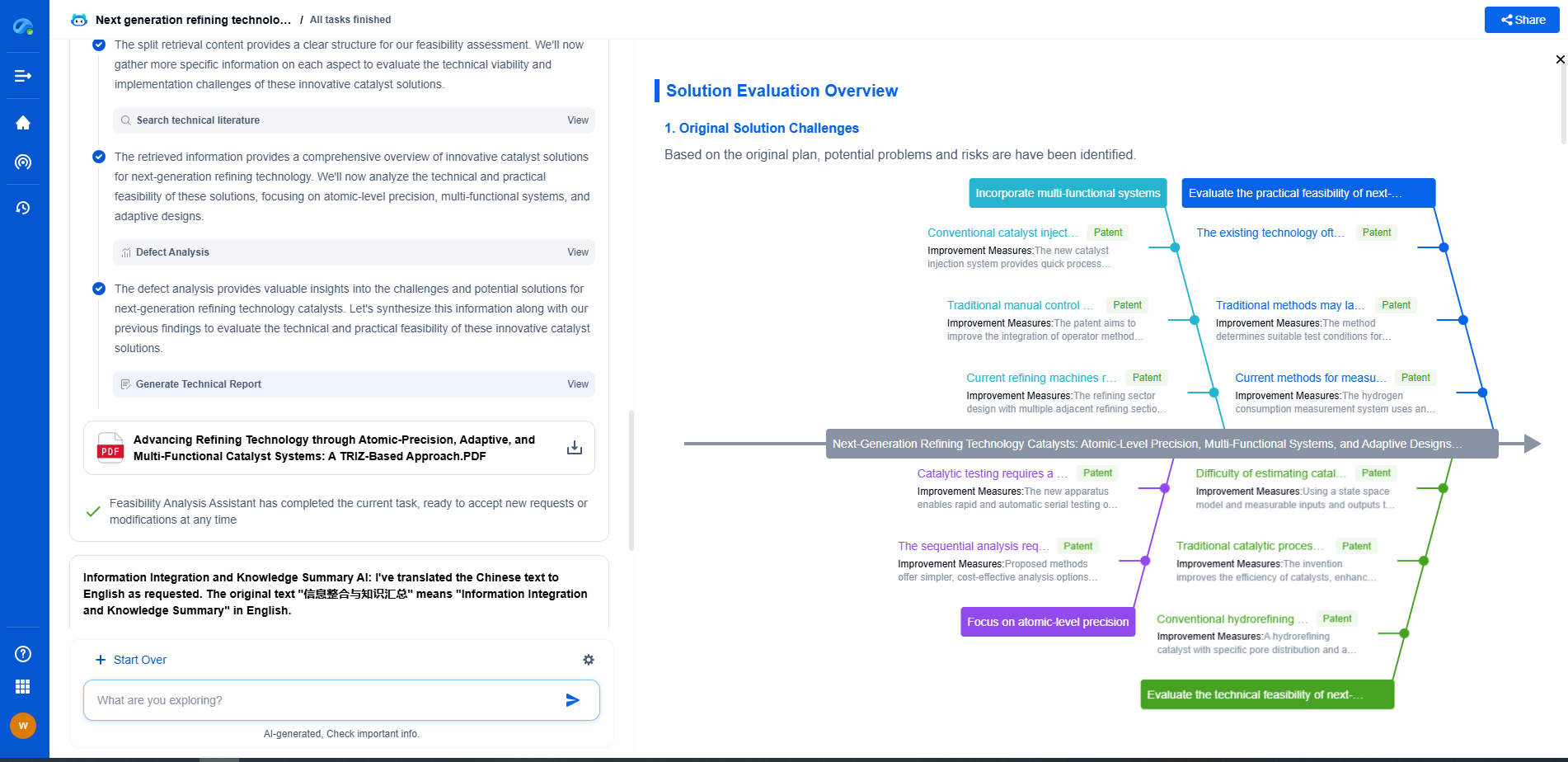Techniques to reduce sulfur in finished fuel
JUN 19, 2025 |
Understanding Sulfur Content in Fuels
Sulfur, naturally present in crude oil, poses significant challenges due to its contribution to air pollution and engine corrosion. When fuels are combusted, sulfur compounds convert into sulfur dioxide (SO2), a precursor to acid rain and a contributor to atmospheric particulates. Therefore, reducing sulfur content not only meets regulatory requirements but also helps in reducing emissions and improving air quality.
Hydrotreating: A Core Technique
Hydrotreating is the most prevalent method for desulfurization in the refining process. This technique involves the catalytic hydrogenation of sulfur compounds, converting them into hydrogen sulfide (H2S) which can be removed. Typically conducted in the presence of a catalyst at high temperatures and pressures, hydrotreating effectively lowers sulfur levels while maintaining the integrity of the fuel.
Advancements in Catalytic Technology
Innovations in catalyst technology have significantly enhanced the efficiency of hydrotreating. Modern catalysts are designed to be more selective and durable, allowing for better conversion rates and longer operational lifespans. These improvements not only boost the effectiveness of sulfur removal but also contribute to cost savings by extending the intervals between catalyst replacements.
Alternative Desulfurization Methods
While hydrotreating remains the dominant method, other techniques have emerged as viable alternatives or supplements:
1. Adsorptive Desulfurization: Utilizing adsorbents like activated carbon or metal oxides, this method targets specific sulfur compounds for removal. Although typically used for niche applications, adsorptive techniques can be highly effective for deep desulfurization.
2. Oxidative Desulfurization: This involves the oxidation of sulfur compounds to form sulfones, which are then extracted. Oxidative desulfurization is favored for its mild operating conditions and potential for integration with existing processes.
3. Biodesulfurization: Using microbial processes to target sulfur compounds, biodesulfurization is an eco-friendly approach that shows promise, particularly for complex fuel mixtures. However, challenges such as reaction rates and scalability remain.
Integrating Desulfurization with Refinery Processes
Successfully reducing sulfur in fuels often involves a strategic integration of desulfurization techniques within the broader refining process. This includes optimizing feedstock selection, managing process conditions, and incorporating advanced monitoring systems to ensure consistent quality and compliance. Refiners also need to balance sulfur removal with the preservation of other desirable fuel properties, such as octane rating and energy density.
Conclusion: The Path Forward
As the global energy landscape evolves, reducing sulfur content in finished fuels will continue to be a priority for refiners. Embracing a combination of advanced technologies, innovative techniques, and strategic process management can help achieve the necessary sulfur reductions while maintaining competitive fuel quality. These efforts not only pave the way for cleaner combustion but also align with the broader goals of environmental stewardship and sustainable energy production.
By focusing on these techniques, the industry can meet the challenges of today and tomorrow, ensuring cleaner fuels and a healthier planet.
Discover Patsnap Eureka: AI Agents Built for Scientific Innovation
Whether you're designing the next generation of refining technologies or analyzing catalysts and process flows, keeping up with rapidly evolving research and IP data in petroleum processing is no easy task.
Patsnap Eureka, our intelligent AI assistant built for R&D professionals in high-tech sectors, empowers you with real-time expert-level analysis, technology roadmap exploration, and strategic mapping of core patents—all within a seamless, user-friendly interface.
Ready to accelerate your innovation process and make smarter, faster decisions? Discover Patsnap Eureka today and unlock the full power of confident, AI-driven innovation.
- R&D
- Intellectual Property
- Life Sciences
- Materials
- Tech Scout
- Unparalleled Data Quality
- Higher Quality Content
- 60% Fewer Hallucinations
Browse by: Latest US Patents, China's latest patents, Technical Efficacy Thesaurus, Application Domain, Technology Topic, Popular Technical Reports.
© 2025 PatSnap. All rights reserved.Legal|Privacy policy|Modern Slavery Act Transparency Statement|Sitemap|About US| Contact US: help@patsnap.com

